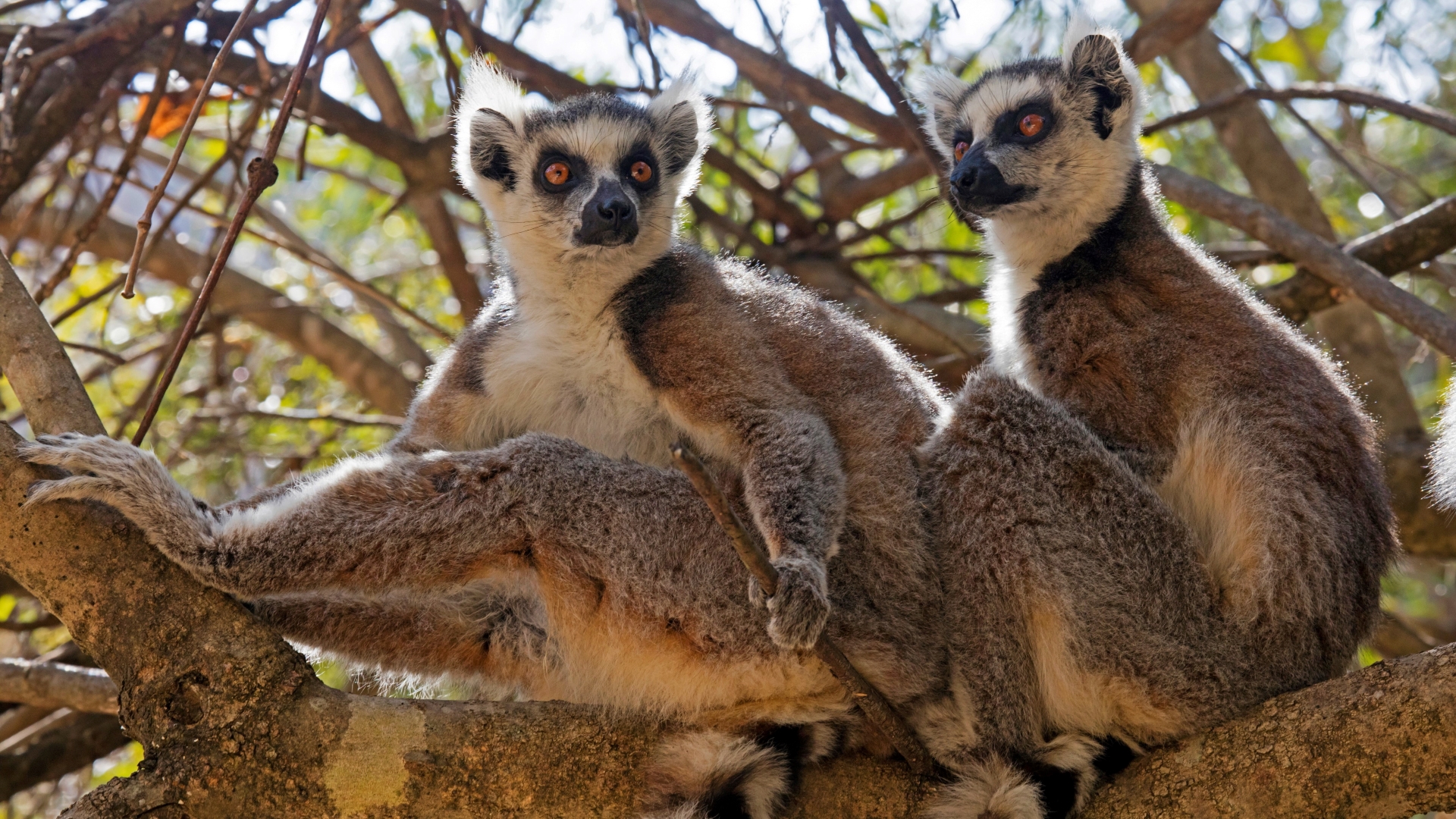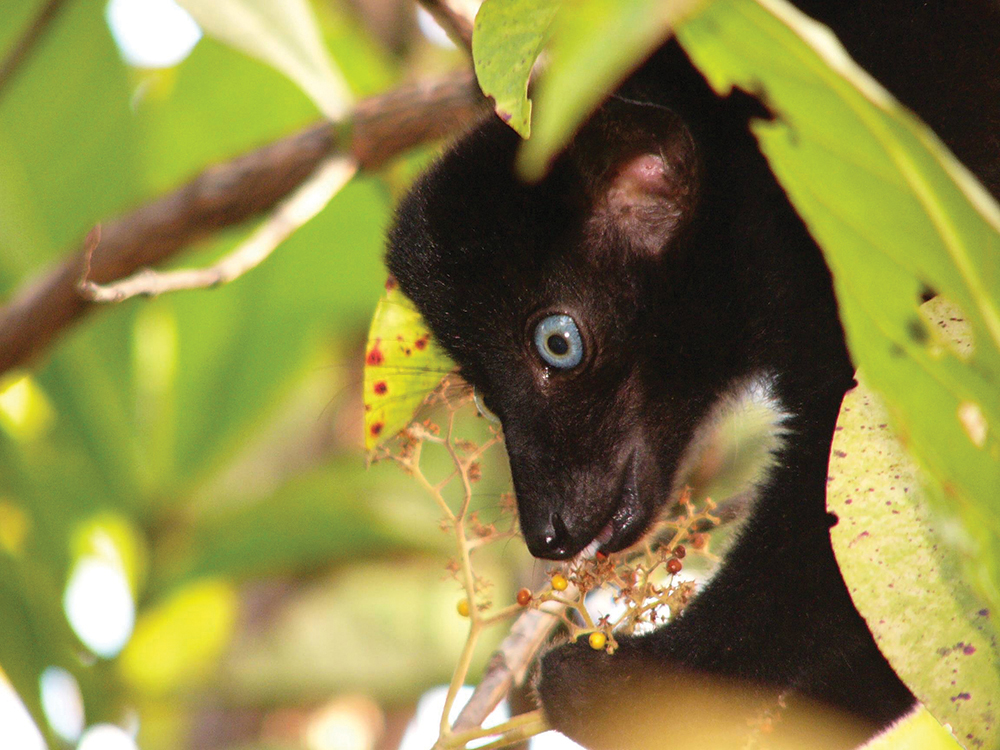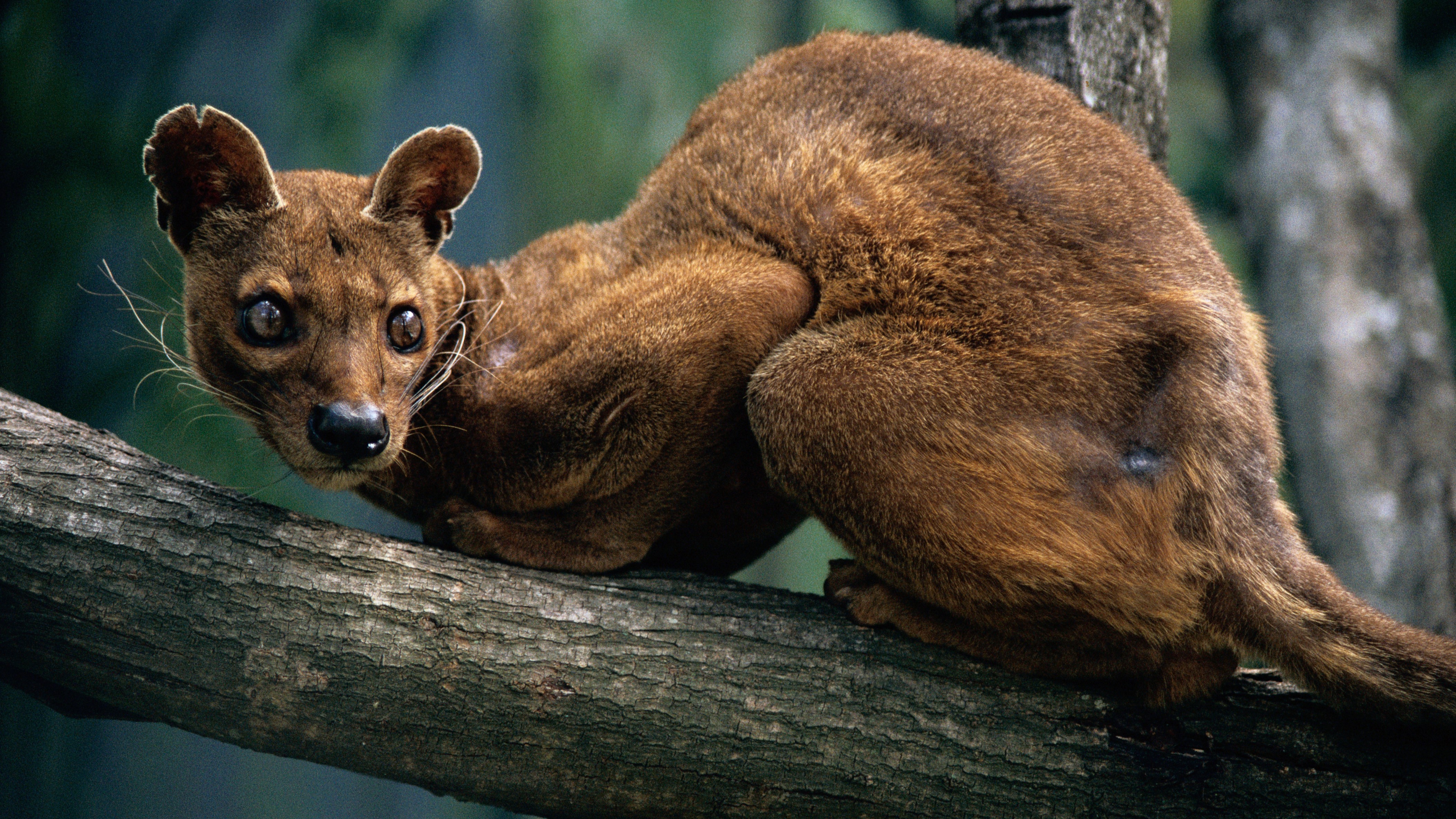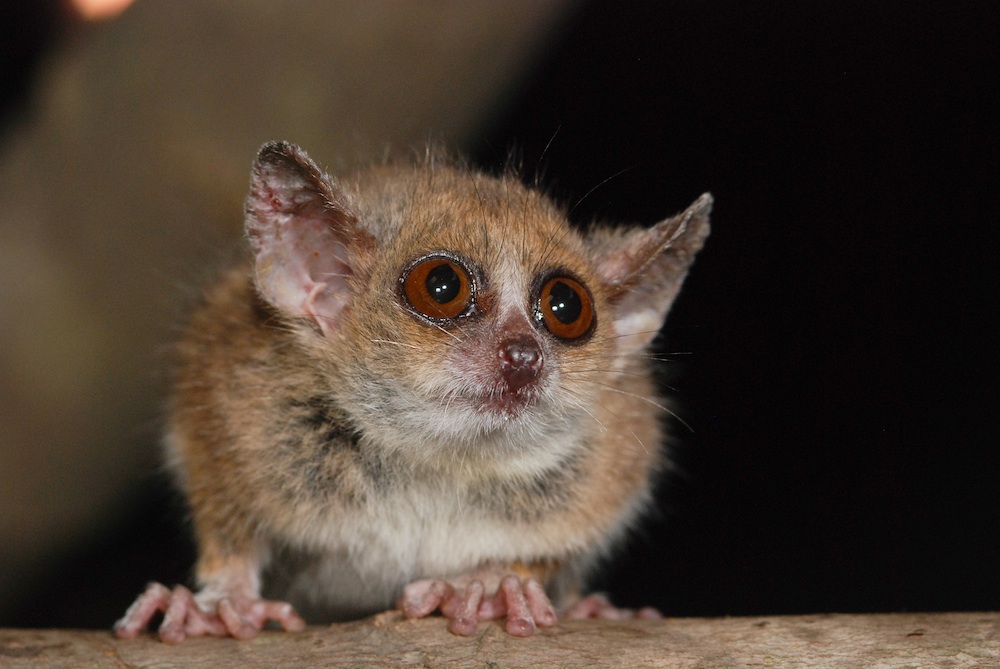Lemurs: A diverse group of endangered primates
Lemurs of Madagascar come in many shapes and sizes.

Lemurs are a unique group of primates native to Madagascar, an island off the coast of east Africa. Although they are related to monkeys and apes, lemurs make up a separate branch of the primate family tree and are classified as a superfamily, made up of five individual lemur families and more than 100 different species.
Lemurs have pointed snouts with wet noses and rely more on their sense of smell than monkeys do, according to the Lemur Conservation Foundation. The lemur superfamily includes ring-tailed lemurs (Lemur catta) popularized by the "Madagascar" film franchise, and the peculiar aye-ayes (Daubentonia madagascariensis) — previously described by Live Science as "so ugly it's cute." Lemurs’ appearance, diet and habitat vary between the different species, but each one plays a role in the rich and varied ecosystems of Madagascar.
After a 2012 assessment of the world's lemur population, the International Union for Conservation of Nature (IUCN) called lemurs the most endangered mammals on Earth, Live Science previously reported. Almost all of the lemurs alive today are threatened with extinction, according to the IUCN.
Types of lemur
There are 113 known lemur species, according to the IUCN, with the potential for more to be discovered. Indri (Indri indri) is the largest lemur species, and can grow to between 24 and 35 inches (61 and 90 centimeters) long and can weigh up to 22 lbs. (10 kilograms), according to the Zoological Society of London (ZSL). Lemurs often have long tails, but indris are the only species to not have one at all.
The smallest lemurs are Madame Berthe's mouse lemurs (Microcebus berthae), which are also the smallest primates in the world. These lemurs grow to just 3.5 to 4 inches (9 to 11 cm) long excluding their tails, which add another 5 to 6 inches (12 to 14 cm) to their length. The tiny lemurs only weigh an average of 1 ounce (30 grams), according to the University of Michigan's Animal Diversity Web (ADW).
Giant lemurs, some the size of gorillas, roamed Madagascar just a few thousand years ago. These included giant sloth lemurs, which had long limbs and hooked fingers like the claws of a modern sloth, although they were lemurs and not sloths, which are a separate group of mammals. Giant sloth lemurs were still living in Madagascar until at least 1,000 years ago, as evidenced by a single cave drawing of a giant sloth lemur being hunted by humans with dogs, according to The Natural History Museum in London.
Size is not the only way to tell lemur species apart — they are often also very unique in appearance. Ring-tailed lemurs are easily recognized by the black rings on their white, fluffy tails. Blue-eyed black lemurs (Eulemur flavifrons) are striking, as they are the only primates other than humans to have blue eyes, according to the San Diego Zoo. Aye-ayes have perhaps the strangest appearance of all lemurs and primates in general, with tiny, bulging eyes, enormous ears and fluffy, long tails. These nocturnal lemurs also have long, skinny fingers that they tap on branches to locate and collect grubs for food.
Get the world’s most fascinating discoveries delivered straight to your inbox.
Related: 'Cursed' primate weirdos have extra thumbs. Scientists didn't know about them until now
Where do lemurs live?
All lemurs are found on Madagascar, an island country off the west coast of Africa in the Indian Ocean. Populations of mongoose lemurs (Eulemur mongoz) and brown lemurs (Eulemur fulvus) also live on the nearby Comoros Islands, between Madagascar and Mozambique, but they were almost certainly introduced to these islands by humans, according to the IUCN.
Related: Species hitched ride to Madagascar on floating islands
Kingdom: Animalia
Phylum: Chordata
Class: Mammalia
Order: Primates
Superfamily: Lemuroidea
Lemurs occupy many different habitats on Madagascar, including rainforests, dry deciduous forests, spiny forests, wetlands and mountains. For example, Sibree's dwarf lemurs (Cheirogaleus sibreei) live in rainforests at altitudes above 4,590 feet (1,400 meters), and white-collared lemurs (Eulemur cinereiceps), also known as gray-headed lemurs, live in a thin strip of tropical, moist lowland forest from sea level up to 2,950 feet (900 m). Lemur habitat is disappearing due to deforestation and their ranges are often highly restrictive.
Some animals, such as Sunda flying lemurs (Galeopterus variegatus) from Southeast Asia, have lemur in their name but are not actually lemurs. True lemurs are only found on Madagascar and nearby islands.
What do lemurs eat?
Many lemurs are herbivores and feed on fruit, flowers, tree bark and sap. Lemurs can be very picky about what they eat, with most of their diet coming from a few tree species, according to the American Museum of Natural History (AMNH). For example, greater bamboo lemurs (Prolemur simus) are highly specialized to eat bamboo, making them Madagascar's equivalent of China's giant pandas (Ailuropoda melanoleuca). A 2017 study published in the journal Current Biology found that greater bamboo lemurs living in Madagascar's Ranomafana National Park get almost all of their food from a single species of woody bamboo called Cathariostachys madagascariensis.
Lemurs are key seed dispersers on Madagascar, which means they help plants reproduce by carrying seeds in their stomach after eating fruit and depositing the seeds into a new area through their feces. Certain plants can be dependent on a single lemur species to disperse their seeds. For example, a 2013 study published in the Journal of Tropical Ecology noted that brown lemurs in a tropical dry forest in northwestern Madagascar are the only disperser for plants with seeds that are more than 0.4 inches (10 millimeters) in diameter. These characteristics make lemurs important for maintaining healthy forests, just as healthy forests are important for providing lemurs with food.
Some lemurs are omnivores and will also eat insects and small vertebrates. Ring-tailed lemurs, for example, will feed on anything that is easily available to them, and their diet can include spiders, chameleons and even small birds, according to ADW.
Lemurs' main predators are fossas (Cryptoprocta ferox) — carnivores that looks a bit like a cat or weasel. Lemurs can also become prey for large snakes, birds, humans and animals humans have introduced to Madagascar, such as domestic cats.
Activity patterns
Lemurs can be diurnal (active during the day), nocturnal (active at night), or cathemeral (active during the day and night), depending on the species, according to the Duke Lemur Center, a research foundation in North Carolina. The time of day cathemeral lemurs, such as brown lemurs, choose to be awake and active can also depend on weather, season and what foods are available to them.
A few lemur species hibernate, such as fat-tailed dwarf lemurs (Cheirogaleus medius). They can hibernate for up to seven months during the dry season when food is more scarce. Fat-tailed dwarf lemurs usually spend this dormant period in hollowed-out tree trunks and survive off fat reserves stored in their tails, according to the Duke Lemur Center.
Ring-tailed lemurs warm up after a cool night by basking in the warm morning sunshine, according to Bristol Zoo Gardens in the U.K. They often sunbathe by sitting upright with their arms spread wide, making it appear as though they are worshipping the sun. Other lemur species, including black-and-white ruffed lemurs, also sunbathe to warm up.
Related: Lemurs snooze in caves like early humans
Lemur life
Lemurs that are active during the day are highly social and live in family groups known as troops. This allows them to alert each other to predators. Nocturnal lemurs, on the other hand, use the cover of darkness to help them hide from predators, according to the San Diego Zoo. However, lemurs have complex social lives and even solitary species may sleep together.
A 2005 study published in the International Journal of Primatology found that nocturnal Madame Berthe's mouse lemurs spent half of their nights sleeping alone and the other half sleeping in groups, which is similar to other mouse lemurs. Sleeping in groups may help largely solitary lemurs stay warm and provide protection against predators that could hunt them while they are resting. Sahamalaza sportive lemurs (Lepilemur sahamalaza) rest and sleep alone, but they use the alarm calls of birds and other lemurs to know when predators are nearby, according to a 2013 study published in the journal PLOS One.
All lemur species apart from aye-ayes have a tooth comb — six teeth fused together at the front of their lower jaw to groom themselves and other lemurs. They also have a secondary tongue under their main tongue called a sublingua, which they use to clean the tooth comb like a toothbrush, according to the Duke Lemur Center.
Related: Lemur faces are unique, facial recognition reveals
Scent is very important when it comes to lemur mating. Male ring-tailed lemurs "stink flirt" with females by rubbing aromatic chemicals secreted from their wrists onto their tails and waving their tails around in the presence of females. The secreted liquid smells bitter and leathery to the human nose for most of the year but becomes more fruity, floral and sweet during the breeding season from April to May, Live Science previously reported. The change in smell could be a sign for females that a male is ready to mate. Male lemurs also use their smelly tails to have stink fights with rival males when competing for the opportunity to breed with females, by seeing who has the strongest scent.
After mating, female lemurs have a gestation period of 102 to 170 days, depending on the species. A female can give birth to between one and six young at a time. Smaller species of lemurs tend to give birth to more babies, according to the San Diego Zoo.
Baby lemurs, called pups, generally cling to their mother's belly for the first three to four weeks of life and then ride on her back until they are 3 to 4 months old. Lemurs can take between one and three-and -a-half years to reach adulthood, depending on the species. The lifespan of lemurs depends on the species as well. According to ADW, gray mouse lemurs (Microcebus murinus) live an average of 14 years in captivity; ring-tailed lemurs usually live 16 years in the wild but may reach 33 years old in captivity; and black-and-white ruffed lemurs (Varecia variegata) can live for more than 35 years in captivity.
Can you have a lemur as a pet?
Lemurs are occasionally kept as pets in the U.S., but many science and conservation organizations, such as the Duke Lemur Center and the Lemur Conservation Foundation, oppose the practice. Lemurs naturally live in complex social groups and are not suited to living with humans in a domestic setting. Pet lemurs also have a strong, unpleasant odor, and often become aggressive when they reach sexual maturity.
A 2019 study published in the journal PLOS One estimated that more than 30,000 wild-caught lemurs were being kept as pets in Madagascar. The study noted that one-third of attempts to keep pet lemurs resulted in the death of the lemur and once they are kept as pets, it's almost impossible to return them to the wild. The motivation for capturing wild lemurs often comes from the tourism industry.
"Tourists love to see lemurs up close and are often willing to pay seemingly small amounts of money to interact or take selfies with lemurs, particularly baby lemurs," Marni LaFleur, an assistant professor at the University of San Diego and co-lead author of the study, said in a statement at the time. "These superficially harmless behaviors, however, in part fuel the illegal extraction of lemurs from the wild and are detrimental to the wellbeing and survival of wildlife globally."
Conservation status
In 2020, the IUCN announced that 98% of all lemurs are threatened with extinction. The main reasons lemur populations have declined so significantly is because of habitat loss due to deforestation and hunting in Madagascar. Their habitat is often destroyed so that it can be used for agriculture, and they are hunted for food.
Related: More than half of all primates threatened with extinction
IUCN data show that 31% of lemur species are listed as critically endangered, which is just one category away from extinction in the wild. Critically endangered lemur species include indris, black-and-white ruffed lemurs, Sibree's dwarf lemurs, blue-eyed black lemurs and mongoose lemurs.
Over 40% of the remaining species of lemurs, including ring-tailed lemurs and aye-ayes, are listed as endangered by the IUCN, and another 20% are classified as being vulnerable to extinction. Gray mouse lemurs and gray-brown mouse lemurs (Microcebus griseorufus) are the only lemur species that are currently not threatened with extinction and are placed in the lowest-risk category. However, the IUCN notes that even these species are likely in decline and may be moved into the threatened category in the future. Finally, Groves' dwarf lemurs (Cheirogaleus grovesi) and Nosy Boraha mouse lemurs (Microcebus boraha) are listed as data deficient, which means there isn't enough information about their populations for the IUCN to make an assessment.
Additional resources
- Illustrated book: "Lemurs of Madagascar" (Conservation International, 2010). Available to buy at Amazon.
- The Lemur Conservation Network website offers more information about lemur conservation.
- The American Museum of Natural History website has a short film about lemurs.
This article was originally written by Live Science contributor Alina Bradford and has since been updated.

Patrick Pester is the trending news writer at Live Science. His work has appeared on other science websites, such as BBC Science Focus and Scientific American. Patrick retrained as a journalist after spending his early career working in zoos and wildlife conservation. He was awarded the Master's Excellence Scholarship to study at Cardiff University where he completed a master's degree in international journalism. He also has a second master's degree in biodiversity, evolution and conservation in action from Middlesex University London. When he isn't writing news, Patrick investigates the sale of human remains.





